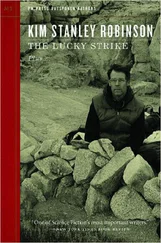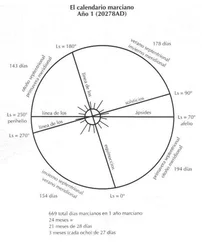Ridiculous, he said.
As a tribute to his courage Zoya had his old organ chemically petrified and airlifted out to the Hellespontus, where it was placed next to the rock tower called Dishes in the Sink. It has since become a popular climbing tower, as you know, sporting scores of routes up it.
And after all the stitches had dissolved and Big Man was physically healed, Zoya took him up to the shores of Chryse Gulf, in midsummer, to a favorite beach of hers, an empty strand on a lost bay.
Will you love me now? Big Man asked her.
I will, Zoya said.
Here again we will draw a curtain and give them some privacy. Suffice it to say that when they came back south, Big Man was light on his feet for the first time; he was walking ten meters off the ground. He hadn’t known it could be so good.
Later on Zoya left him and broke his heart, unfortunately, and he had to get used to that, as well as to his organ being just a sweet little thing between his legs. It was kind of strange, but not really bad. It meant that when he met other human women he liked, he was sometimes able to form quite satisfactory relationships with them. And occasionally he would run into Zoya, and sometimes they would renew their old affair, with considerable passion. So that all in all, in the long run, looking at everything that had happened since and putting it all in the balance, he judged that it had been worth it. And the climbers on Mars continue to appreciate the decision as well.
Chapter 19
An Argument for the Deployment of All Safe Terraforming Technologies
The Oxia River runs heavy with silt after storms on Margaritifer Terra, and the muddy water pours through the sandbars at the river’s mouth and stains Chryse Gulf as red as blood, in a bloom extending three or four kilometers out toward the archipelago on the horizon. When the flow recedes, and the silt settles to the bottom, the river’s channel is almost always changed. The mouth might have moved all the way to the other end of the beach. The old channel then silts up, its underwater banks continuing to serve as point breaks for incoming waves, until the waves wear them down. It’s all new, week by week, storm by storm—except for the elements involved, of course: sun, sea, sky; the bluffs nosing out into the sea, the river canyon between them; the river’s final beach-dammed lagoon, the dunes, the river water rippling out the break and over the tide bars to slide under the waves of the shorebreak. These are always there.
“Always” in the relative sense, of course. I mean that for years it had been this way. But on Mars the landscape is a matter of perpetual change. Punctuated equilibrium, as Sax once said, without the equilibrium. And the cooling of the 2210s, the years without summer, was such that if something were not done, this river-mouth scene would not exist like this for many more years.
But the methods that seemed to contain any hope of stopping the trend sounded drastic indeed. For someone who loves the land, the idea of a million thermonuclear explosions in the deep regolith is a shocking thing, an ugly thing. You can make all the arguments you like about the containment of radiation, about the essential heat from below, even about the disposal of old Terran weapons, and still it doesn’t seem like something an environmentalist should approve.
And it didn’t help that there were advocates using the stupidest language possible to argue for the various heavy-industrial methods being proposed. These were people who did not understand the power of language. They would speak casually of a “manifest destiny” for Mars, as if this phrase did not come from a determinate moment in American history, a moment inextricably tied to imperialist wars of conquest, to idiot yahoo patriotism, and to a genocide that most Americans still did not like to admit had occurred. So that to use that horrible old phrase to describe the rescue of the Martian biosphere was insane; but some people did it anyway.
And other people, like Irishka, were extremely put off by it. And all because of words. I sat through the whole of that session of the global environmental court, listening to the arguments pro and con, and though my work is in words I thought to myself, This is absurd, this is horrible. Language is nothing but a huge set of false analogies. There has to be a better way to make one’s point.
So when the session was over I got Irishka and her partner Freya to come with me, and we took the equatorial piste west to Ares Fjord, then drove northwest up the shore of Chryse Gulf to the gravel road that went out to Soochow Point, above the Oxia River’s broad beach of a mouth. Early one summer morning we drove around a turn in the sea-cliff road, and all was clear. The horizon was a clean line between sea and sky. Both were blue: the sky a very dark blue with purplish tinges, as if there were a red shell above the blue one; the sea a blue almost black, its water on this day transparent to a great depth. The land was the usual red rock, though here tinted blackish, as it tended to be through the region, darkening as you move east toward black Syrtis. There was no wind, and the stillness of the water was such that the waves broke as in a wave tank in a physics class, peeling cleanly across their breaks, purring in, leaving white tapestries fizzing behind them, until the shorebreak foamed up the wet red strand.
I saw right away that the bottom had changed again in the most recent storm. There was a new point break off to the far left side of the beach. And this offshore sandbar was angled perfectly to the morning’s incoming swell, which was fairly big. Probably there was a hard wind blowing down Kasei’s great canyon and fjord on the other side of Chryse Gulf, creating these waves some thirteen hundred kilometers away. We could see the swells right out to the horizon, crests perfectly spaced and slightly bowed toward us, like arcs of a circle bigger than the Chryse Gulf itself, sweeping in to curl around Soochow Point and onto our beach, one after the next, all pitching over first at the new point break, then breaking in a continuous clean line all the way across the beach to the new river mouth, far to the right. The break was swift but not too swift, and each was slightly different, of course, shallow bowls giving way to quick walls, or long tubular sections purling over in perfect clear waterfalls. Conditions could never be more perfect. “Oh my God,” Irishka said. “Heaven has come.”
We parked on the bluff just above the beach, got out of the car and put on our wetsuits, then walked down the path and across the beach with flippers in hand. The shorebreak foam ran over our booties and we hooted at the cold water seeping into our wetsuits at the calves—it was about eight or ten degrees, but quickly warmed up. We walked out to where it was waist-deep, then put on fins and pulled up our wetsuit hoods, and dived under the next breaker. Though only our faces were exposed, that was enough to have us all screaming at the shock of the cold, standing again chest deep. We breasted out, still on foot, turning our backs when the waves crashed into us, then dived under a tall white wall of broken water and started swimming.
It was hard work getting outside. The waves always look smaller from the beach, and smaller still from up on a bluff, especially when there’s no one riding them to give you a sense of scale. Now we saw firsthand that the broken waves were walls between two and three meters overhead, and getting under one of those can be a workout if you don’t do it right. And no matter how good wetsuits have gotten, it still feels cold in them at first.
I dived deep just before a wall hit me and relaxed, letting the bottom of the wave’s underwater revolution shove me back. A bit of turbulence shook me like a flag in a wind, then pushed me up hard, out of the break. I hit the surface swimming head-up freestyle as hard as I could, through the hissing wrack to the next boiling wall, where I dived under again. If you time it right, so that you use the waves’ underwater action to help you, it makes getting out much easier than if you fight the break directly. Irishka is a real master at this, and on this day as always she was already far ahead of us.
Читать дальше
Конец ознакомительного отрывка
Купить книгу












